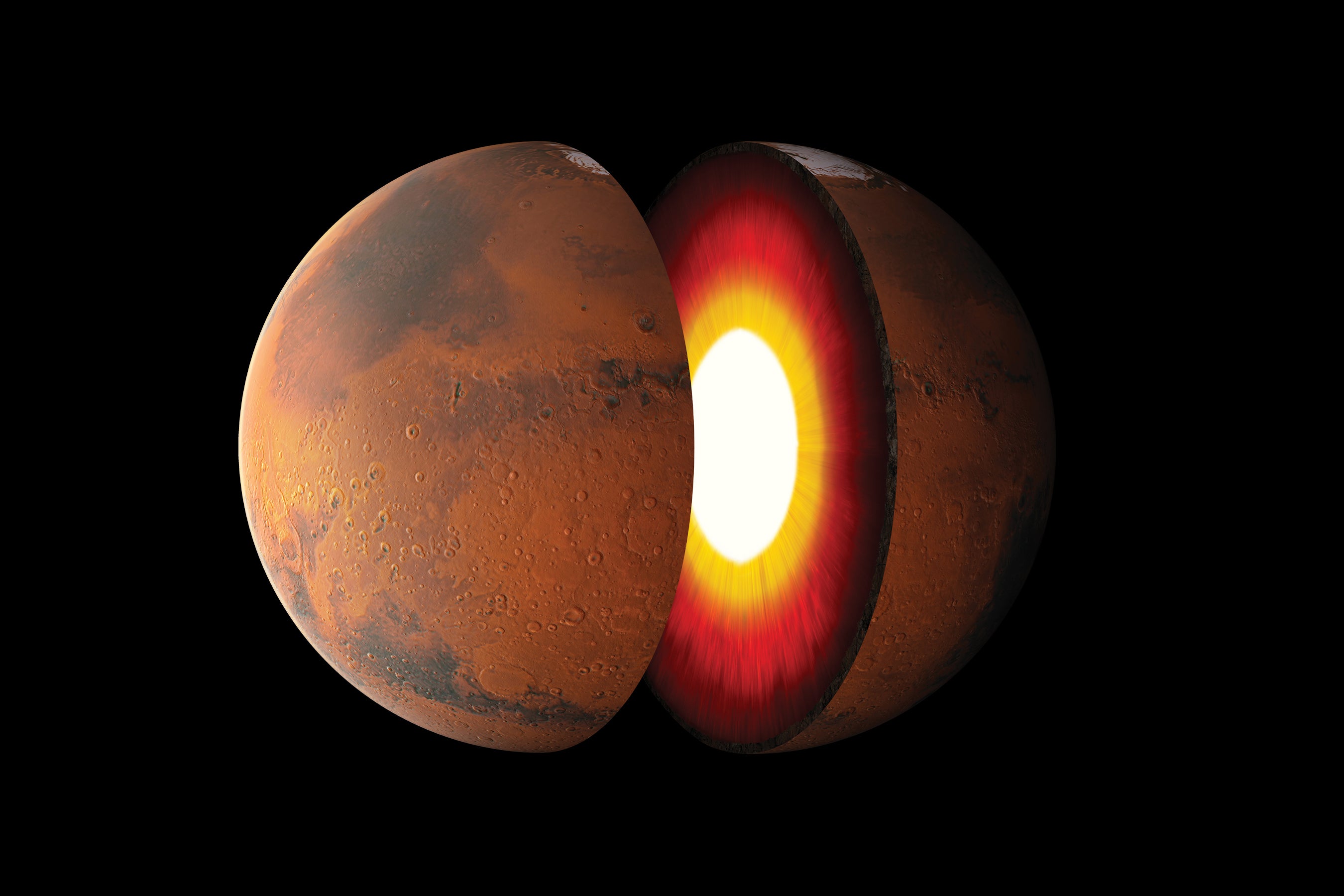
A meteorite that slammed into Mars in September 2021 has rewritten what scientists know about the planet’s interior.
By analysing the seismic energy that vibrated through the planet after the impact, researchers have discovered a layer of molten rock that envelops Mars’s liquid-metal core. The finding, reported today in two papers in Nature, means that the Martian core is smaller than previously thought. It also resolves some lingering questions about how the red planet formed and evolved over billions of years.
The discovery comes from NASA’s InSight mission, which landed a craft with a seismometer on Mars’s surface. Between 2018 and 2022, that instrument detected hundreds of ‘marsquakes’ shaking the planet. Seismic waves produced by quakes or impacts can slow down or speed up depending on what types of material they are travelling through, so seismologists can measure the waves’ passage to deduce what the interior of a planet looks like. On Earth, researchers have used information from earthquakes to discover the planet’s layers: a brittle outer crust, a mostly solid mantle, a liquid outer core and a solid inner core. Finding out whether other planets have similar layers is key to understanding their geological history, including whether they were ever suitable for life.
InSight’s seismometer was the first to detect marsquakes. In July 2021, on the basis of the mission’s observations of 11 quakes, researchers reported that the liquid core of Mars seemed to have a radius of around 1,830 kilometres. That was bigger than many scientists were expecting. And it suggested that the core contained surprisingly high amounts of light chemical elements, such as sulfur, mixed with iron.
But the September 2021 meteorite impact “unlocked everything,” says Henri Samuel, a geophysicist at the Institute of Earth Physics of Paris and lead author of one of today’s papers. The meteorite struck the planet on the side opposite to where InSight was located. That’s much more distant than the marsquakes that InSight had previously studied, and allowed the probe to detect seismic energy travelling all the way through the Martian core. “We were so excited,” says Jessica Irving, a seismologist at the University of Bristol, UK, and a co-author of Samuel’s paper.
Puzzle solving
For Samuel, it was an opportunity to test his idea that a molten layer of rock surrounds Mars’s core. The way the seismic energy traversed the planet showed that what scientists had thought was the boundary between the liquid core and the solid mantle, 1,830 kilometres from the planet’s centre, was actually a different boundary between liquid and solid. It was the top of the newfound layer of molten rock meeting the mantle (see ‘Rethinking the Martian core’). The actual core is buried beneath that molten-rock layer and has a radius of only 1,650 kilometres, Samuel says.
The revised core size solves some puzzles. It means that the Martian core doesn’t have to contain high amounts of light elements — a better match to laboratory and theoretical estimates. A second liquid layer inside the planet also meshes better with other evidence, such as how Mars responds to being deformed by the gravitational tug of its moon Phobos.
“It’s an elegant solution,” says Simon Stähler, a seismologist at the Swiss Federal Institute of Technology (ETH) Zurich who led the team that published the 2021 paper. He stands by his team’s conclusion that it had spotted a deep boundary between liquid and solid; it just turned out to be the top of a molten-rock layer rather than the top of the liquid-metal core.
Peculiar layering
The second paper in Nature today, from a team independent of Samuel’s, agrees that Mars’s core is enveloped by a layer of molten rock, but estimates that the core has a radius of 1,675 kilometres. The work analysed seismic waves from the same distant meteorite impact, as well as simulations of the properties of mixtures of molten elements such as iron, nickel and sulfur at the high pressures and temperatures in the Martian core. Having molten rock right up against molten iron “appears to be unique,” says lead author Amir Khan, a geophysicist at ETH Zurich. “You have this peculiarity of liquid–liquid layering, which is something that doesn’t exist on the Earth.”
The molten-rock layer might be left over from a magma ocean that once covered Mars. As it cooled and solidified into rock, the magma would have left behind a deep layer of radioactive elements that still release heat and keep rock molten at the base of the mantle, Samuel says.
The InSight lander is now out of commission, its solar panels covered in dust, so it’s unlikely that scientists will gather any evidence that could substantially revise Mars’s core size again any time soon. But reviews of the mission’s past observations might reveal some new details of what’s inside Mars.
This article is reproduced with permission and was first published on October 25, 2023.
